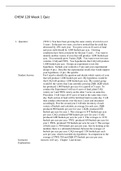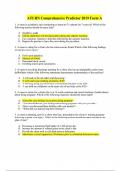Exam (elaborations)
CHEM 120 Quiz 1, Quiz 2, Quiz 3, Quiz 4, Quiz 5- Each Multiple Versions, Best document for preparation, Verified And Correct Answers Course Number: CHEM120 Course Title: Introduction to General, Organic & Biological Chemistry with Lab Chamberlain College
- Course
- Institution
CHEM 120 Quiz 1, Quiz 2, Quiz 3, Quiz 4, Quiz 5- Each Multiple Versions, Best document for preparation, Verified And Correct Answers Course Number: CHEM120 Course Title: Introduction to General, Organic & Biological Chemistry with Lab Chamberlain College of Nursing
[Show more]




